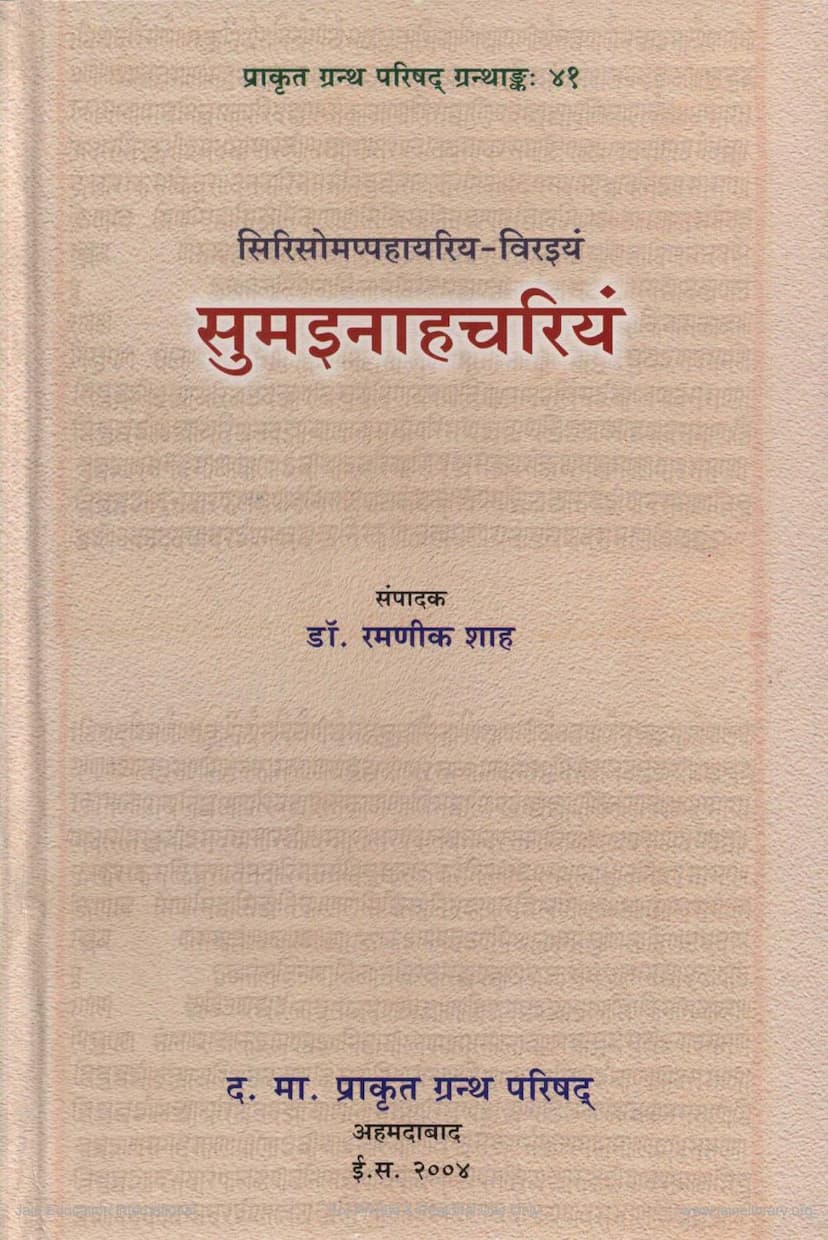Sumainahchariyam
Added to library: September 2, 2025

Summary
Here's a comprehensive summary of the Jain text "Sumatināhacariya" based on the provided pages:
Title: Sumatināhacariya (The Life of Sumatinātha)
Author: Ācārya Śrī Somaprabhāsūri
Publisher: D. M. Prakrit Text Society, Ahmedabad
Year of Publication: 2004
Series: Prakrit Granth Parishad Series No. 41
Overview:
"Sumatināhacariya" is a significant work by the renowned Jain Ācārya Somaprabhāsūri, who was a contemporary of the famous King Kumārapāla and Ācārya Hemacandra of the Śvetāmbara tradition. The text is written in Prakrit and is a campū (a genre combining prose and poetry), detailing the life and teachings of Lord Sumatinātha, the fifth Tīrthaṅkara of the present era. The book, meticulously edited by Dr. Ramnik Shah, aims to bring this important, previously unpublished text to the scholarly world.
Key Aspects of the Text:
-
Author and His Significance:
- Ācārya Somaprabhāsūri was the 43rd paṭṭadhara (spiritual successor) in his lineage.
- He was a talented poet, also known for his famous work "Kumārapālaprathibodha" (also known as Jinhdharma Prathibodha or Hemakumāracarita), which was published earlier in the Gāyakaḻāḍ Oriental Series.
- "Sumatināhacariya" is considered his first major literary work, possibly composed during Kumārapāla's reign.
- The praśasti (colophon) at the end of the book provides details about his guru lineage, which traces back through Ācārya Ajitadevasūri and Vijayasinhaguru to the illustrious Acāryas Municandrasūri and Śrīmāndevasūri of the Candragaccha.
- The text reveals that Ācārya Somaprabhāsūri composed "Sumatināhacariya" while residing in the pauṣadhaśālā (monastic lodging for temporary residence, often for lay ascetics or monks) of the poet Śrīpāla, who was a friend of King Kumārapāla. Śrīpāla himself was the son of the poet Kavicakramastaka Maṇi Siddhapāla, a minister to King Siddharāja Jayasiṃha.
-
Content and Structure:
- The book recounts the life of Lord Sumatinātha, focusing on his previous lives and his final life as a Tīrthaṅkara.
- The original work was divided into two parts: the pūrvārdha (first half), detailing two previous lives, and the uttarārdha (second half), describing his Tīrthaṅkara life.
- The edited version is structured into ten prastāvas (chapters or sections), with five sections dedicated to the former lives and five to the Tīrthaṅkara life.
- The text is primarily in Maharaṣṭrī Prakrit but incorporates Sanskrit prose and verse in certain sections, particularly in the descriptions of karmic influences (Prastāva 5) and a narrative concerning a pulinda couple's devotion to the Pañcaperameṣṭhi mantra (Prastāva 9). It also features Apabhramśa verses.
- The work is not just a biography but also a repository of didactic tales (kathākośa), illustrating Jain principles through engaging narratives. The author states his purpose in writing the work is to disseminate the story of Lord Sumatinātha for the benefit of others and to quell inner enemies, not for personal fame or to create wonder.
-
Key Themes and Narratives:
- Previous Lives: The text elaborates on Lord Sumatinātha's previous births, highlighting the cultivation of virtues and the accumulation of tīrthaṅkara karma. The first previous life described is that of Prince Puruṣasiṃha, whose story, filled with valor, righteousness, and spiritual growth, is extensively detailed.
- Encounter with Adharma and Virtue: The narratives often showcase the consequences of actions, the power of virtue, the allure of worldly pleasures, and the importance of spiritual discipline.
- Debates and Wisdom: The text includes dialogues and teachings, such as the one between Prince Puruṣasiṃha and his wives, where sixteen different illustrative stories are presented to demonstrate various ethical and philosophical points.
- Jain Philosophy and Practices: The stories illustrate concepts like karmic bondage and liberation, the significance of vows (vratas), the fruits of good deeds (puṇya) and the suffering caused by bad deeds (pāpa), the importance of faith (samyaktva), knowledge (jñāna), conduct (cāritra), and devotion (bhakti).
- Integration of Cultures: The inclusion of Sanskrit and Apabhramśa elements, along with stories drawing from folk traditions, showcases the cultural richness and literary prowess of the author and the period.
- Lord Sumatinātha's Life: The later sections describe his birth, education, renunciation, attainment of omniscience (kevala jñāna), preaching, and final liberation (nirvāṇa). The narratives from Gaṇadhara Cama's discourse further elucidate Jain doctrines.
-
Manuscript Sources and Editorial Process:
- The present edition is based on a copy made from a manuscript preserved in the 'Lavārnī Poḷ Jain Jñāna-Bhāṇḍār' in Ahmedabad, initially collected by the late Muni Śrī Puṇyavijaya II.
- Additional comparative readings from three other manuscripts were also used.
- The editor, Dr. Ramanik Shah, received further assistance from Paramapujya Ācārya Śrī Pradyumnasūriji, who provided Xerox copies of two more manuscripts, which proved helpful in correcting Apabhramśa passages.
- Six manuscripts in total were consulted: L (Lavārnī Poḷ), P (Pāṭan's Hema Candrācārya Jñāna Mandir), R (Rādhapur), D (Devashāno Pāḍo Jñāna Bhāṇḍār), H (Pāṭan's Hema Candrācārya Jñāna Bhāṇḍār, No. 15657), and V (Kālūśīkī Poḷ, Vimalgacch Upāśraya, Ahmedabad, No. 3380).
- The text is divided into ten chapters (prastāvas), with verse numbering revised from the original manuscripts.
-
Literary and Scholarly Value:
- "Sumatināhacariya" is invaluable for studying Prakrit language, Jain religion and philosophy, the tradition of secular storytelling, and contemporary cultural aspects.
- The work demonstrates Ācārya Somaprabhāsūri's mastery over Sanskrit, Prakrit, and Apabhramśa languages and his skill in various poetic meters.
- The introduction by Dr. N. J. Shah highlights the text's importance for understanding Jain dharma, philosophy, and narrative traditions.
In essence, "Sumatināhacariya" is presented as a detailed, instructive, and spiritually enriching narrative of Lord Sumatinātha's life, attributed to the erudite Ācārya Somaprabhāsūri, making it a valuable addition to Jain literature and scholarship.